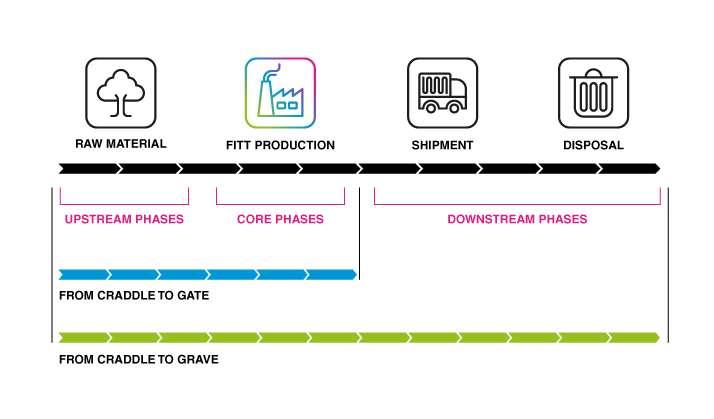Gafa 2023 has come to an end. The event saw FITT consolidate its responsibility journey, announced to the public during the 2019 edition of Gafa and restated in 2022 with the launch of its sustainability strategy, The Responsible Flow. Together with innovation, which has always been the driving force behind FITT’s business, leading to the […]
Environmental impact of plastics: how to calculate it
The subject of plastics is extremely complex. In in order to assess the actual sustainability of a plastic, one must take into account the consequences throughout the entire life cycle: from the impacts generated during the extraction of the raw materials and their processing, to the performance guaranteed during the life of the product, through to its management and end-of-life.
Also, it is crucial not to generalise:
the sustainability strategy must be designed for the specific material and sector of application.
A company who wants to innovate its products with a view towards environmental sustainability, needs a tool that allows a holistic assessment of the potential impacts in the different environmental compartments throughout the life cycle of the product.
LCA – Life Cycle Assessment: what it is and how it works
The internationally recognised method for assessing the environmental sustainability of a product is the Life Cycle Assessment (LCA). Standardised according to international standards ISO 14040 and 140044, the LCA analyses the environmental aspects and the potential environmental impacts of a product throughout its life cycle, from the acquisition of the raw material to production, from use to end of life (cradle to grave).
According to the ISO 14040 standard, an LCA study must be structured in four consequential steps: definition of purpose and scope, inventory analysis, impact assessment, interpretation and improvement.
The purpose and scope definition stage
This stage entails the definition of the object of the study, the functional unit, i.e. the product unit on which the analysis will focus, and the life cycle stages considered in the study:
- “From Cradle to Gate”: from the extraction of the raw materials to the product leaving the production site;
- “From Cradle to Grave”: from the extraction of the raw materials to the end of life disposal of the product.

The inventory analysis stage
This includes the collection of all input and output data relating to the system object of the study, building a model that represents it as truthfully as possible
The Impact Assessment stage
In this third stage, inventory data (stage two) are associated with specific categories of environmental impacts. The environmental impact categories are:
- Depletion of abiotic resources and depletion of biotic resources: they provide for the safeguard of human welfare, human health and the ecosystems, and the extraction of minerals and fossil fuels.
- Acidification: this refers to substances that have a wide range of impacts on soil, underground water, surface water, organisms, ecosystems and materials (buildings).
- Atmospheric ozone depletion: this relates to the depletion of the stratospheric ozone, which can have harmful effects of human health, animal health, earth and water ecosystems, biochemical cycles and materials.
- Climate change: measured in CO2 equivalent, this is linked to greenhouse gas emissions into the air and can have adverse effects on ecosystem health, human health and material well-being.
- Eutrophication: this includes all the impacts resulting from excessive levels of macro-nutrients in the air, caused by the emission of nutritional substances in the air, water and soil.
- Formation of photo-oxidants: this is the formation of reactive substances (mainly ozone) that are harmful to human health and ecosystems and can also damage crops. This problem is also referred to as summer smog, whereas winter smog does not fall into this category.
- Water consumption: this indicator assesses the water resource depletion potential, both for mankind and the ecosystems, based on the assumption that the less water remains available, the more likely it is that a further user, be it a human or an ecosystem, will be deprived of it (Boulay et al., 2016).
The results interpretation stage
This is the final stage of the LCA procedure, in which the results are summarised and discussed according to the purpose and scope definition.
This stage entails the clear and transparent presentation of the results of the study carried out: by identifying the components on which action can be taken, changes can be made to reduce the environmental impact of the entire system.
FITT and the measurement of its own environmental impact
Also FITT, in partnership with Centro Studi Qualità e Ambiente (Centre for Quality and Environmental Studies) – CESQA – of the Industrial Engineering Department of the University of Padua, has chosen to measure the environmental impacts of its leading products through LCA analysis.
The Life Cycle Assessment (LCA) is an empirical tool based on the collection and analysis of data that enables the scientific mapping of impacts, the identification of areas for improvement and transparent communication to all stakeholders. Transparency and innovation – aimed at creating better products, better performing and with less impact -, together with interdependence -with the proactive contribution of all those involved in the supply chain -, are the three principles at the basis of FITT’s responsibility strategy.
FITT’s objective is to measure the environmental impact of 80% of its products by 2030.